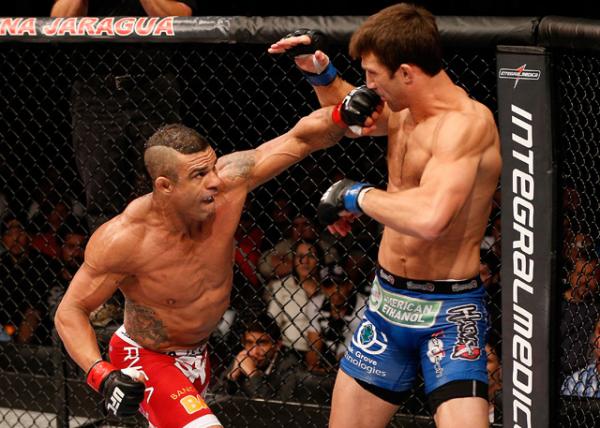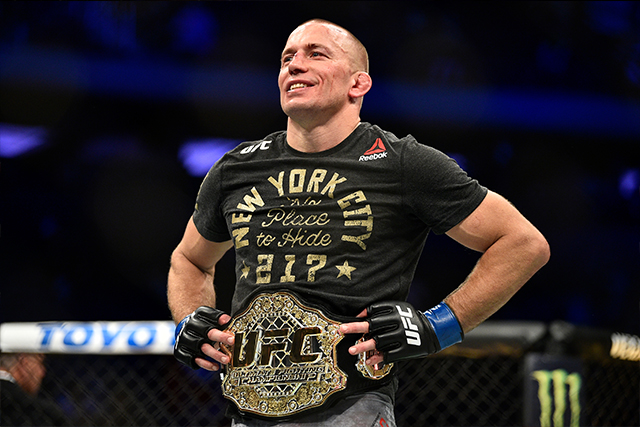Sherdog.com’s 2013 Story of the Year
Story of the Year

Vitor Belfort enjoyed a phenomenal but controversial year. |
Photo: Josh Hedges/Zuffa LLC/Getty Images
This year saw no shortage of head-turning stories in mixed martial arts.
Two Ultimate Fighting Championship divisions long defined by the dominance of exceptional men are now suddenly wide open, as Anderson Silva was dethroned by Chris Weidman and Georges St. Pierre vacated his belt after narrowly escaping with a split decision over Johny Hendricks.
Advertisement
With all of the aforementioned news making waves, Sherdog.com’s editorial staff had no easy task in selecting the “Story of the Year” for 2013. However, after much deliberation, we thought the raging debate over testosterone replacement therapy stood slightly taller than the rest. Though TRT has been a controversial topic for some time, the discussion picked up more steam last year. Forrest Griffin and Frank Mir received therapeutic use exemptions in Nevada, and Quinton Jackson told Fighter’s Only he had used TRT before his UFC 144 bout with Ryan Bader.
No fighter drew more attention than veteran Vitor
Belfort, who scored a trio of devastating knockouts over
Michael
Bisping, Luke
Rockhold and fellow TRT user Dan
Henderson. Although fighters like Chael Sonnen
and “Hendo” have typically been the ones most associated with the
treatment, Belfort eclipsed them thanks to his dominance in the
cage.
Belfort received TUEs from the UFC for his three fights -- all of which took place in Brazil -- despite previously testing positive for the anabolic steroid 4-hydroxytestosterone in 2006. “The Phenom” was suspended nine months and fined by the Nevada Athletic Commission for his positive test, a result that Belfort explained was the result of taking an over-the-counter supplement called Max Tribustak, which, unbeknownst to Belfort, contained the banned steroid.
UFC President Dana White has come to Belfort’s defense on the subject, stating that the fighter does not abuse his treatment and should be allowed to use TRT as long as that remains the case. When first asked about his testosterone use, Belfort was initially reserved, but the veteran later opened up to Sherdog.com in August.
“It’s a big issue, I think -- but let’s find out [about] the people who are doing steroids and don’t get caught. Why? Why don’t they do blood work on all the fighters? I was the only guy in the history of MMA drawing blood after a fight. People are talking about the Brazilian commission. The commission here is so much tougher than in America,” Belfort said. “I was doing blood work every week before a fight. With TRT, after a shot, you cannot do blood work right away, because the shot [needs to level out] in your system.
“Bottom line, my level is always lower than a regular guy. I never go to the limit of the level,” he added. “What I’m trying to do is just be fair with my career against my opponent. The [testosterone] is just something that my body cannot produce, and I’m doing a treatment with doctors with blood work. Everything is black and white, but a lot of guys are out there doing stuff, and they don’t get caught, because they don’t [have to do blood work].”
Belfort was not the only fighter in 2013 to use TRT, as Sonnen, Henderson, Mir, Ben Rothwell, Lavar Johnson and Antonio Silva also fought while on the treatment. Sonnen and Henderson competed without issue, but both Rothwell and Silva saw post-fight drug tests flagged for elevated levels of testosterone. The same thing happened to Johnson, though “Big” never disclosed his use to the California State Athletic Commission and therefore never received an exemption.
Some fighters, like Tim Kennedy, Michael Bisping and Jon Jones, have publicly come out against TRT. Others, like Shane Roller and Nate Marquardt, previously used the treatment but then stopped because of the potential stigma surrounding it.
The real question: Is the use of TRT fair, and why are more and more professional fighters apparently being afflicted with low testosterone? Regulators must also look at the differences between primary hypogonadism, which is present at birth, and secondary hypogonadism, which is acquired. Many reasons for the latter condition have been brought up in the online MMA community, from weight-cutting to head trauma to simply getting older, stirring even more interest in the topic.
To provide a medical perspective, Sherdog.com’s fight doctor and FightMedicine.net founder Jon Gelber weighed in on the issue in a recent email:
“There is a long laundry list of causes of low testosterone, but several of them are potentially applicable to MMA fighters or other athletes. They include anabolic steroid abuse, painkiller abuse, head trauma and weight cutting. Of these, head trauma, weight cutting and anabolic steroid abuse are the most controversial.
“Hypogonadism (low testosterone and related diseases) caused by pituitary dysfunction from major head trauma has been shown in studies published in fairly reputable journals. However, whether MMA athletes receive head trauma large enough to cause this remains a question.
“Low testosterone from weight cutting or weight loss is less studied, and even those studies that have looked at it don’t show a direct causation between weight loss and low levels of testosterone. For example, one often-cited study of wrestlers competing in several bouts during a single-day tournament showed that while testosterone levels do decline below normal from the beginning of the tournament to the end, shortly after the matches the testosterone levels actually spike above normal (Barbas et al, Eur J Appl Physiol. 2011). In addition, there is a lot more going on during a tournament than simply weight loss. Thus, it’s hard to draw a straight line from weight loss to low levels of testosterone.
“Anabolic steroids are the easiest line to draw, since the endocrine system is a feedback loop and the body signals the production of testosterone when there are low levels circulating in the blood. However, when an athlete takes anabolic steroids, the body can convert this to testosterone and the body doesn't know that it didn’t produce it, so it stops producing it. Then, when the fighter stops taking steroids, the body may not be able to rev the production back up.
“Aging does cause a gradual lower production level of testosterone but usually not to the level that would require supplementation. The recent trend of prescribing testosterone to combat aging is controversial in the medical community and not the accepted standard at this point, despite the huge push by pharmaceutical companies and commercials.”
Much is made of the potential performance-enhancing aspects associated with TRT, but what are the risks of using the treatment, and is it potentially as risky to decline TRT if one is truly in need?
“There is no real data to say someone would die from going off testosterone who wasn’t born with a low testosterone level,” Gelber said. “Most people who study this will tell you that if that was the case [that they were born with testosterone dysfunction], the fighter never would have been able to make it to where they are today, as their bodies would not have been performing at an elite level.
“The No. 1 risk is that they irreparably inhibit their own body’s production of testosterone by the negative feedback loop,” he added. “In addition, they can suffer clogged arteries and cardiovascular issues. Some think it may increase the risk of prostate cancer, but this has not yet been strongly proven. There are also risks for acne and testicle shrinkage/low sperm count [just] like [with] anabolic steroids.”
As Gelber previously mentioned, the practice of prescribing testosterone to combat aging is on the rise in general and not just for athletes, which seems to indicate this debate is far from over. Whether TRT is eventually phased out or becomes an accepted part of the sport, MMA fans can look on 2013 as the year in which the issue was discussed and debated more than ever before.
Number Two » Women in the UFC
Related Articles







